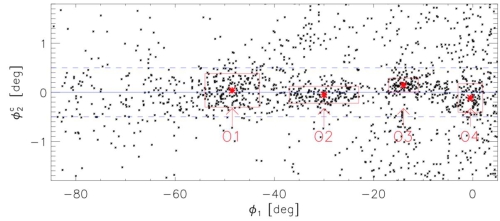The GD-1 was discovered by Grillmair and Dionatos in 2006, and named by the first letters of discoverer names. Combining data from LAMOST (also called Guoshoujing Telescope) DR6, Gaia DR2 and SDSS DR14, Guang-Wei Li, Brian Yanny and Yue Wu found that the progenitor of the GD-1 is a globular cluster, which is a spherical collection of stars that orbits the Galactic core as a satellite, but later, this globular cluster was torn apart and stretched out along its orbit by the Galactic tidal forces. As a result, it now becomes a very thin (0.5° wide) but very long (90° long) stellar stream on the sky.
The age of GD-1 is about 13 billion years, the abundance of elements that are heavier than helium is only 1/200 times that of Sun, and the distance is about 260,000 light years from the Sun. They also found six spectroscopic blue horizontal branch (BHB) stars and 10 spectroscopic blue stragglers (BS) of GD-1, respectively.
The GD-1 stream has an orbit of eccentricity of 0.3, perigalacticon of 46,300 light years, apogalacticon of 88,000 light years, and inclination of 40°.
The GD-1 stream has four stellar overdensities, and a spur parallel to the stream. The narrowest overdensity is curved and has the highest stellar density, so it is thought where the center of the progenitor of the GD-1 stream should be located.
These substructures along the stream will help us understand how a globular cluster is torn by the Galactic potential, the interaction process between the Galactic plane and a stellar stream, the distribution of massive subhalos and the interaction process between a massive subhalo and a stream. Besides, the orbit of the GD-1 steam can be used to constrain the Galactic circular velocity at the Sun’s radius and the shape of the Galactic potential.

Figure 1. The left panel is the color-magnitude diagram from SDSS DR9. The red line is the isochrone with [Fe/H] = -2.3(1/200 times that of Sun), an age of 1.3×1010 years and a distance of 8 kpc (260,000 light years). The right panel shows the positions of six blue horizontal branch stars and 10 blue stragglers by boxes. The black dots are the background stars, while circles are spectroscopic stars of the GD-1stream. The red circles are from LAMOST, while the blue circles from SDSS.

Figure 2. The stellar density fluctuation on the GD-1 stream. The four stellar overdensities are indicated by red boxed and named by O1, O2, O3 and O4 respectively. The progenitor should be located at O3.

Address: 20A Datun Road, Chaoyang District, Beijing, China code: 100012
Tel: 010-64888708 E-mail: naoc@nao.cas.cn

